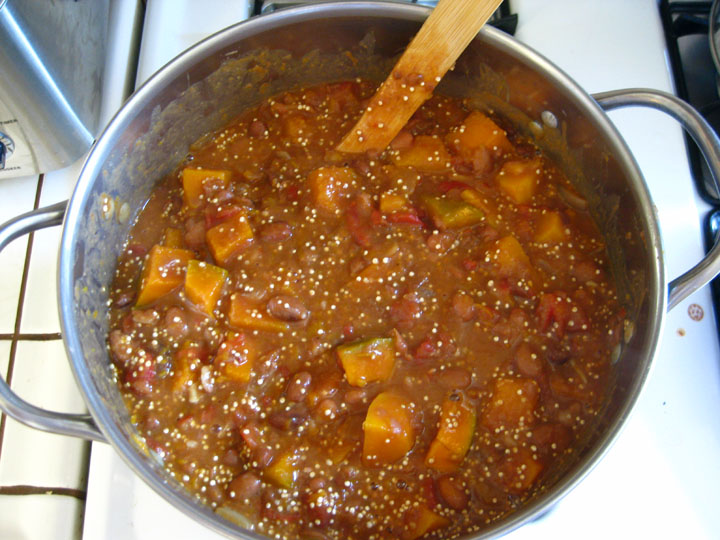Are You Bean Careful?
 Yesterday I mentioned that if you are going to use dried beans for cooking you should pick them over for pebbles before using them. Today I want to show you that I’m not kidding.
Yesterday I mentioned that if you are going to use dried beans for cooking you should pick them over for pebbles before using them. Today I want to show you that I’m not kidding.
For my apartment’s last Soup Night I decided to make a recipe I found in the New York Times. The recipe was for Andean Bean Stew With Winter Squash and Quinoa, and it called for a pound of dried pinto beans. Since I was cooking for 20 people I doubled the recipe and bought a full 2 lbs of dried beans.
That’s a lot of beans, folks.
 Because of the huge volume I had to be extra careful when looking for pebbles. To pick through beans I like to lay them out on a large cookie sheet, as shown. You can sort through a smaller amount of beans on a solid-colored plate or even in a clear bag on the counter.
Because of the huge volume I had to be extra careful when looking for pebbles. To pick through beans I like to lay them out on a large cookie sheet, as shown. You can sort through a smaller amount of beans on a solid-colored plate or even in a clear bag on the counter.
As you can see from the top picture, 2 lbs of beans from the bulk bin at Whole Foods yielded 4 not-so-small pebbles.
Finding these little guys didn’t take more than a minute or two, and I guarantee you my guests appreciated the extra effort.
Let this be your warning. I do not wish to send you into shark-filled waters if you happened to be inclined to go buy dried beans this weekend. The last thing I need is a bunch of angry emails from your dentists!
Lentils are known to harbor pebbles as well, so searching for small rocks is a good habit to cultivate with all dried legumes.
The Soup
On the food front, the recipe turned out absolutely amazing! Since doubling the recipe required two whole winter squash anyway, I chose one large butternut squash and one kabocha squash. Both were delicious, but I was particularly fond of the kabocha (just look at that color!). It was denser, but the texture was creamier and the flavor more sweet and nutty than the butternut.
 Peeling the kabocha was no easy task, however. I always just use a vegetable peeler for butternut, but on the kabocha the skin was so tough this was not an option. Instead I boiled it whole for 3 minutes on each side (it floats) and took the skin off with a pairing knife. Alright, I admit I had a boy do the peeling.
Peeling the kabocha was no easy task, however. I always just use a vegetable peeler for butternut, but on the kabocha the skin was so tough this was not an option. Instead I boiled it whole for 3 minutes on each side (it floats) and took the skin off with a pairing knife. Alright, I admit I had a boy do the peeling.
Does anyone have an easier way to peel a kabocha?
The Andean stew was very hearty, but our guests were not shy about finishing every last drop. I highly recommend it, particularly for a cold winter weekend.
This picture was taken after the quinoa was added but before it finished cooking.

Don’t forget to bean careful!
UPDATE: I have since learned that a kabocha does not need peeling. If it is cooked through the skin is soft and edible. My new favorite trick is to cut one in half, scoop out the seeds and roast it face down for 40 minutes. Mmmm.




 Health
Health Habits
Habits Food
Food Weight
Weight 



 Better Than Butternut: Roasted Delicata Squash Recipe
Better Than Butternut: Roasted Delicata Squash Recipe 10 Simple Ways To Eat Less Without Noticing
10 Simple Ways To Eat Less Without Noticing Juicing: Stupid and Pretentious or Nourishing and Enlightening?
Juicing: Stupid and Pretentious or Nourishing and Enlightening? 10 Tasty Carbs That Won’t Make You Fat
10 Tasty Carbs That Won’t Make You Fat How To Start Working Out When You Don’t Like To Exercise
How To Start Working Out When You Don’t Like To Exercise
 Focus More on Your Brain and Less on Your Diet if You’re Serious About Losing Weight
Focus More on Your Brain and Less on Your Diet if You’re Serious About Losing Weight Home Court Habits: The Secret to Effortless Weight Control
Home Court Habits: The Secret to Effortless Weight Control 10 Reasons You Aren’t Losing Weight When You Think You’re Doing Everything Right
10 Reasons You Aren’t Losing Weight When You Think You’re Doing Everything Right How To Burn More Calories Without Breaking A Sweat
How To Burn More Calories Without Breaking A Sweat The 7 Habits of Highly Effective Foodists
The 7 Habits of Highly Effective Foodists







